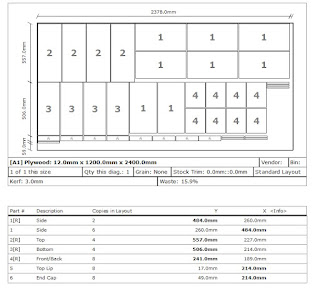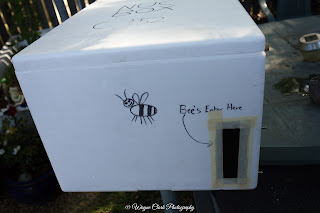Did I mention rain? Its been very wet here in South East Queensland, since the weekend it has rained pretty much constant until late yesterday evening and although today is predicted to be clear, as of tomorrow (Saturday) its supposed set in each day for at least until mid next week. Not that I'm complaining, we need the rain in this part of the world but it has made my beekeeping beginnings a little awkward. To start, I left the bees 2 weeks from the last inspection, so on Saturday again I had a look while my daughter helped out for the first time. All seemed well but in lifting the inner cover the amount of Small Hive Beetle there was startled me. There was probable 10 or so on the mat, I'm not sure yet if that's something to worry about or not with still being so new to all these issues. I do use traps, 2 AJ traps per box and a reusable DE (diatomaceous earth) traps shown below.
Originally I used DE in the AJ traps, I research and found they were meant to have vegetable oil in them to drown the beetle. I also read though that people used DE as it is effective and didn't go everywhere when trying to install or remove them from the hive. When I had them in after the hive was initially installed it seemed to work well, but was told that maybe oil would be better so I gave it ago. I'm not saying it doesn't work, but the mess of trying to get it in the trap then install it or remove it was quite the pain. There were a fair few in the traps but I found they were running dry anyway where as DE doesn't "run out". What DE is, is basically microscopic crushed up coral that acts like razor blades to the gaps in an insects exoskeletal plates and also dries them out, yet is perfectly safe to humans. The DE traps sit on the bottom board and is designed for DE. I have decided to go back to DE for the AJ traps.
After checking the hive I decided they were ready for a honey super, I found they had all frames full and covered in bees. So I put that on with a Queen Excluder, and before I put the lid on I found a bunch of SHB in the corner of the lid, circled by bees guarding them, this is what bees do, they push them into a corner and keep them there, that's how traps work, the beetle try and hide in them to get away. I thought it was amazing and super cute when a bee chased a runner SHB back into the herd. I used my hive tool to crush them all before replacing the lid.
So that's where the rain comes in, that night, the weather report came in with rain. Great! not... I still am not sure if rain is getting in the hive or not. This is a bad thing with the bottom board traps, especially if you use poison based ones, but more on that later. With solid board hives you lean the hive forward slightly so the rain runs out, problem is, how much do you lean it, the only real advice is not too much.... how long is a piece of string? I don't know, I had around 2cm at one point but worried this was too much, so backed it off to around 1cm at the front. I then kept worrying again about the amount of SHB, and decided to go what most of the club use and that's Apithor traps, a poison style trap. Problem with them is that they are poison, so must be kept away from water, or it will run out of the trap and effect the bees. Our president puts his on top of the frames in the hive but at the last meeting it was explained how this isn't as effective and could get into the frames themselves. so whats the option? stop the rain getting in the hive.
First the Apithor Trap, it was developed after what many keepers DIY'd, they often used core flute board with poisons inside the holes and put it in the hive, put small holes in a CD case to do a similar thing, well this works both these ideas, it has poison covered wavy cardboard in it that is appitising to SHB and a hard shell exterior with a small slot for the SHB to go into. Put it on the bottom board, the SHB go in through the entrance and get chased straight away into the trap. There they eat the poison they cant resist and die quickly.
But still what about the rain? Well I had originally worried about the rain when thinking the lean was not enough, due to moisture in the hive not being an ideal situation, but it run out quickly enough to not become a problem. My thought was a roof, on top of the hive, which I made cheaply out of strap sealed ply and foam, its sticks out enough to stop light rain but its mostly to keep them cooler on really hot days. On heavy rains, wind blown rain or storms the rain would still get in due to the fact this roof would be way to high from the entrance. So I thought originally an awning or patio style shield, which is what I made, out of scrap tin sheet, and 16x16x 25mm pine. I put this at what I felt was a good height to keep rain out but enough to not get in their way while landing, and the few that do miss judge will land on it and climb down anyway, they get into much trickier spots in the wild. It all cost maybe $2 for 2 of them, and took only 10 minutes to make. This will stop the rain getting in and allow the use of an Apithor trap
Simple, yet effective. Even if using 10, 50 or 100 hives, this could be a cost effective way to keep out water and use Apithor traps. All just in time for the impending downpour coming!
 | |||
| AJ Trap with DE. |
 |
| AJ Trap. |
 |
| DE Trap. |
After checking the hive I decided they were ready for a honey super, I found they had all frames full and covered in bees. So I put that on with a Queen Excluder, and before I put the lid on I found a bunch of SHB in the corner of the lid, circled by bees guarding them, this is what bees do, they push them into a corner and keep them there, that's how traps work, the beetle try and hide in them to get away. I thought it was amazing and super cute when a bee chased a runner SHB back into the herd. I used my hive tool to crush them all before replacing the lid.
So that's where the rain comes in, that night, the weather report came in with rain. Great! not... I still am not sure if rain is getting in the hive or not. This is a bad thing with the bottom board traps, especially if you use poison based ones, but more on that later. With solid board hives you lean the hive forward slightly so the rain runs out, problem is, how much do you lean it, the only real advice is not too much.... how long is a piece of string? I don't know, I had around 2cm at one point but worried this was too much, so backed it off to around 1cm at the front. I then kept worrying again about the amount of SHB, and decided to go what most of the club use and that's Apithor traps, a poison style trap. Problem with them is that they are poison, so must be kept away from water, or it will run out of the trap and effect the bees. Our president puts his on top of the frames in the hive but at the last meeting it was explained how this isn't as effective and could get into the frames themselves. so whats the option? stop the rain getting in the hive.
First the Apithor Trap, it was developed after what many keepers DIY'd, they often used core flute board with poisons inside the holes and put it in the hive, put small holes in a CD case to do a similar thing, well this works both these ideas, it has poison covered wavy cardboard in it that is appitising to SHB and a hard shell exterior with a small slot for the SHB to go into. Put it on the bottom board, the SHB go in through the entrance and get chased straight away into the trap. There they eat the poison they cant resist and die quickly.
But still what about the rain? Well I had originally worried about the rain when thinking the lean was not enough, due to moisture in the hive not being an ideal situation, but it run out quickly enough to not become a problem. My thought was a roof, on top of the hive, which I made cheaply out of strap sealed ply and foam, its sticks out enough to stop light rain but its mostly to keep them cooler on really hot days. On heavy rains, wind blown rain or storms the rain would still get in due to the fact this roof would be way to high from the entrance. So I thought originally an awning or patio style shield, which is what I made, out of scrap tin sheet, and 16x16x 25mm pine. I put this at what I felt was a good height to keep rain out but enough to not get in their way while landing, and the few that do miss judge will land on it and climb down anyway, they get into much trickier spots in the wild. It all cost maybe $2 for 2 of them, and took only 10 minutes to make. This will stop the rain getting in and allow the use of an Apithor trap
Simple, yet effective. Even if using 10, 50 or 100 hives, this could be a cost effective way to keep out water and use Apithor traps. All just in time for the impending downpour coming!
Cheers
Wayne



















































